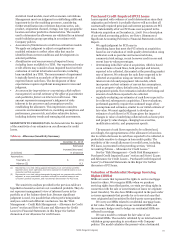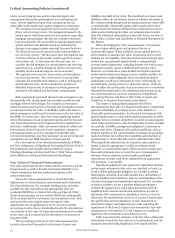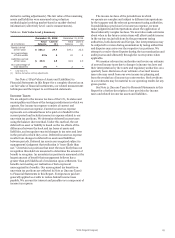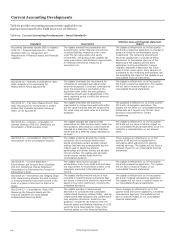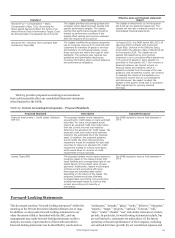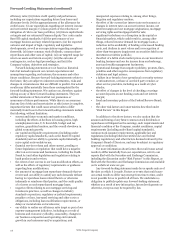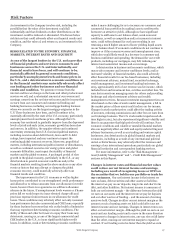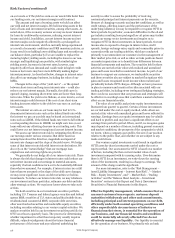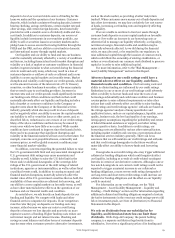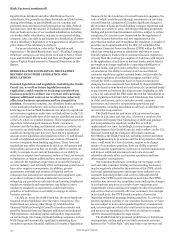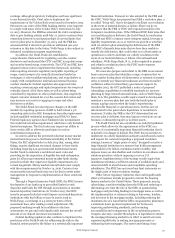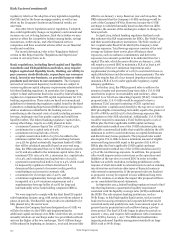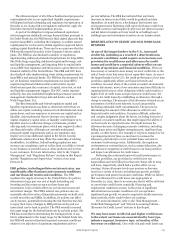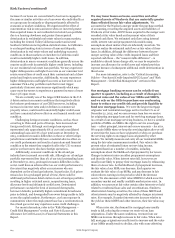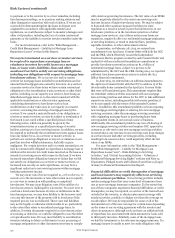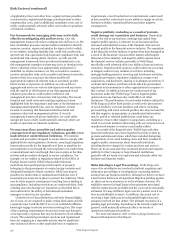Wells Fargo 2015 Annual Report Download - page 122
Download and view the complete annual report
Please find page 122 of the 2015 Wells Fargo annual report below. You can navigate through the pages in the report by either clicking on the pages listed below, or by using the keyword search tool below to find specific information within the annual report.Risk Factors (continued)
liquidity from dividends and other distributions from its
subsidiaries. We generally use these dividends and distributions,
among other things, to pay dividends on our common and
preferred stock and interest and principal on our debt. Federal
and state laws limit the amount of dividends and distributions
that our bank and some of our nonbank subsidiaries, including
our broker-dealer subsidiaries, may pay to our parent holding
company. Also, our right to participate in a distribution of assets
upon a subsidiary’s liquidation or reorganization is subject to the
prior claims of the subsidiary’s creditors.
For more information, refer to the “Regulation and
Supervision – Dividend Restrictions” and “– Holding Company
Structure” sections in our 2015 Form 10-K and to Note 3 (Cash,
Loan and Dividend Restrictions) and Note 26 (Regulatory and
Agency Capital Requirements) to Financial Statements in this
Report.
RISKS RELATED TO FINANCIAL REGULATORY
REFORM AND OTHER LEGISLATION AND
REGULATIONS
Enacted legislation and regulation, including the Dodd-
Frank Act, as well as future legislation and/or
regulation, could require us to change certain of our
business practices, reduce our revenue and earnings,
impose additional costs on us or otherwise adversely
affect our business operations and/or competitive
position. Our parent company, our subsidiary banks and many
of our nonbank subsidiaries such as those related to our
brokerage and mutual fund businesses, are subject to significant
and extensive regulation under state and federal laws in the U.S.,
as well as the applicable laws of the various jurisdictions outside
of the U.S. where we conduct business. These regulations protect
depositors, federal deposit insurance funds, consumers,
investors and the banking and financial system as a whole, not
necessarily our stockholders. Economic, market and political
conditions during the past few years have led to a significant
amount of new legislation and regulation in the U.S. and abroad,
as well as heightened expectations and scrutiny of financial
services companies from banking regulators. These laws and
regulations may affect the manner in which we do business and
the products and services that we provide, affect or restrict our
ability to compete in our current businesses or our ability to
enter into or acquire new businesses, reduce or limit our revenue
in businesses or impose additional fees, assessments or taxes on
us, intensify the regulatory supervision of us and the financial
services industry, and adversely affect our business operations or
have other negative consequences. In addition, greater
government oversight and scrutiny of financial services
companies has increased our operational and compliance costs
as we must continue to devote substantial resources to
enhancing our procedures and controls and meeting heightened
regulatory standards and expectations. Any failure to meet
regulatory standards or expectations could result in fees,
penalties, or restrictions on our ability to engage in certain
business activities.
On July 21, 2010, the Dodd-Frank Act, the most significant
financial reform legislation since the 1930s, became law. The
Dodd-Frank Act, among other things, (i) established the
Financial Stability Oversight Council to monitor systemic risk
posed by financial firms and imposes additional and enhanced
FRB regulations, including capital and liquidity requirements,
on certain large, interconnected bank holding companies such as
Wells Fargo and systemically significant nonbanking firms
intended to promote financial stability; (ii) creates a liquidation
framework for the resolution of covered financial companies, the
costs of which would be paid through assessments on surviving
covered financial companies; (iii) makes significant changes to
the structure of bank and bank holding company regulation and
activities in a variety of areas, including prohibiting proprietary
trading and private fund investment activities, subject to certain
exceptions; (iv) creates a new framework for the regulation of
over-the-counter derivatives and new regulations for the
securitization market and strengthens the regulatory oversight of
securities and capital markets by the SEC; (v) established the
Consumer Financial Protection Bureau (CFPB) within the FRB,
which has sweeping powers to administer and enforce a new
federal regulatory framework of consumer financial regulation;
(vi) may limit the existing pre-emption of state laws with respect
to the application of such laws to national banks, makes federal
pre-emption no longer applicable to operating subsidiaries of
national banks, and gives state authorities, under certain
circumstances, the ability to enforce state laws and federal
consumer regulations against national banks; (vii) provides for
increased regulation of residential mortgage activities; (viii)
revised the FDIC's assessment base for deposit insurance by
changing from an assessment base defined by deposit liabilities
to a risk-based system based on total assets; (ix) permitted banks
to pay interest on business checking accounts beginning on July
1, 2011; (x) authorized the FRB under the Durbin Amendment to
adopt regulations that limit debit card interchange fees received
by debit card issuers; and (xi) includes several corporate
governance and executive compensation provisions and
requirements, including mandating an advisory stockholder vote
on executive compensation.
The Dodd-Frank Act and many of its provisions became
effective in July 2010 and July 2011. However, a number of its
provisions still require final rulemaking or additional guidance
and interpretation by regulatory authorities or will be
implemented over time. Accordingly, in many respects the
ultimate impact of the Dodd-Frank Act and its effects on the U.S.
financial system and the Company still remain uncertain.
Nevertheless, the Dodd-Frank Act, including current and future
rules implementing its provisions and the interpretation of those
rules, could result in a loss of revenue, require us to change
certain of our business practices, limit our ability to pursue
certain business opportunities, increase our capital requirements
and impose additional assessments and costs on us and
otherwise adversely affect our business operations and have
other negative consequences.
Our consumer businesses, including our mortgage, credit
card and other consumer lending and non-lending businesses,
may be negatively affected by the activities of the CFPB, which
has broad rulemaking powers and supervisory authority over
consumer financial products and services. Although the full
impact of the CFPB on our businesses is uncertain, the CFPB’s
activities may increase our compliance costs and require changes
in our business practices as a result of new regulations and
requirements which could limit or negatively affect the products
and services that we currently offer our customers. For example,
in 2013 and 2015, the CFPB issued a number of new rules
impacting residential mortgage lending practices. As a result of
greater regulatory scrutiny of our consumer businesses, we have
become subject to more and expanded regulatory examinations
and/or investigations, which also could result in increased costs
and harm to our reputation in the event of a failure to comply
with the increased regulatory requirements.
The Dodd-Frank Act’s proposed prohibitions or limitations
on proprietary trading and private fund investment activities,
known as the “Volcker Rule,” also may reduce our revenue and
Wells Fargo & Company
120



